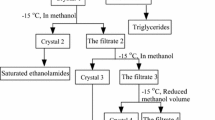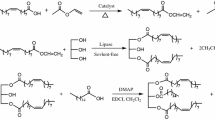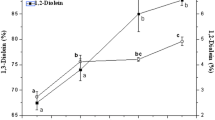Abstract
Certain N-acylethanolamines interact with cannabinoid receptors and have anorexic and neuroprotective effects. Traditional methods for the synthesis of N-acylethanolamines use fatty acid chlorides, fatty acid methyl esters, free fatty acids and triacylglycerols as acyl donors to react with ethanolamine. In the present study, we investigated the feasibility of using fatty acid vinyl esters as the acyl donor to synthesize N-stearoyl and N-palmitoylethanolamine. Theoretically, the use of fatty acid vinyl esters should lead to an irreversible reaction because the volatile acetaldehyde by-product is easily removed. Four reaction conditions, i.e. catalyst concentration, substrate ratio, temperature, and time were evaluated. The reaction performed at mild temperatures and with an excess amount of ethanolamine which acted as both reactant and solvent resulted in the formation of high purity N-stearoyl and N-palmitoylethanolamine. When 20 mmol ethanolamine was reacted with 1 mmol vinyl stearate at 80 °C for 1 h with 1% sodium methoxide as catalyst, N-stearoylethanolamine with 96% purity was obtained after the removal of excess ethanolamine without further purification, while N-palmitoylethanolamine with 98% purity was obtained by reacting with the same substrate ratio at 60 °C for 1.5 h with 3% catalyst. Complete conversion of vinyl stearate and palmitate was achieved.







Similar content being viewed by others
References
Liu KJ, Nag A, Shaw JF (2001) Lipase-catalyzed synthesis of fatty acid diethanolamides. J Agric Food Chem 49:5761–5764
Sanders HL (1958) Fatty acid alkylolamides. J Am Oil Chem Soc 35:548–551
Feairheller S, Bistline R, Bilyk A, Dudley R, Kozempel M, Haas M (1994) A novel technique for the preparation of secondary fatty amides. J Am Oil Chem Soc 71:863–866
Kilaru A, Blancaflor EB, Venables BJ, Tripathy S, Mysore KS, Chapman KD (2007) The N-acylethanolamine-mediated regulatory pathway in plants. Chem Biodivers 4:1933–1955
Re G, Barbero R, Miolo A, Di Marzo V (2007) Palmitoylethanolamide, endocannabinoids and related cannabimimetic compounds in protection against tissue inflammation and pain: potential use in companion animals. Vet J 173:21–30
Terrazzino S, Berto F, Carbonare MD, Fabris M, Guiotto A, Bernardini D, Leon A (2004) Stearoylethanolamide exerts anorexic effects in mice via down-regulation of liver stearoyl-coenzyme A desaturase-1 mRNA expression. FASEB J 18:1580
Calignano A, La Rana G, Giuffrida A, Piomelli D (1998) Control of pain initiation by endogenous cannabinoids. Nature 394:277–281
Aloe L, Leon A, Levi-Montalcini R (1993) A proposed autacoid mechanism controlling mastocyte behaviour. Inflamm Res 39:145–147
Lambert DM, Vandevoorde S, Diependaele G, Govaerts SJ, Robert AR (2001) Anticonvulsant activity of N-palmitoylethanolamide, a putative endocannabinoid, in mice. Epilepsia 42:321–327
Ross RA, Brockie HC, Pertwee RG (2000) Inhibition of nitric oxide production in RAW264. 7 macrophages by cannabinoids and palmitoylethanolamide. Eur J Pharmacol 401:121–130
Costa B, Conti S, Giagnoni G, Colleoni M (2002) Therapeutic effect of the endogenous fatty acid amide, palmitoylethanolamide, in rat acute inflammation: inhibition of nitric oxide and cyclo-oxygenase systems. Br J Pharmacol 137:413–420
Thabuis C, Tissot-Favre D, Bezelgues JB, Martin JC, Cruz-Hernandez C, Dionisi F, Destaillats F (2008) Biological functions and metabolism of oleoylethanolamide. Lipids 43:887–894
Astarita G, Di Giacomo B, Gaetani S, Oveisi F, Compton TR, Rivara S, Tarzia G, Mor M, Piomelli D (2006) Pharmacological characterization of hydrolysis-resistant analogs of oleoylethanolamide with potent anorexiant properties. J Pharmacol Exp Ther 318:563
Okamoto Y, Wang J, Morishita J, Ueda N (2007) Biosynthetic pathways of the endocannabinoid anandamide. Chem Biodivers 4:1842–1857
Ezzili C, Otrubova K, Boger DL (2010) Fatty acid amide signaling molecules. Bioorg Med Chem Lett 20:5959–5968
Giuffrida A, Rodriguez de Fonseca F, Nava F, Loubet-Lescoulié P, Piomelli D (2000) Elevated circulating levels of anandamide after administration of the transport inhibitor, AM404. Eur J Pharmacol 408:161–168
Koutek B, Prestwich GD, Howlett AC, Chin SA, Salehani D, Akhavan N, Deutsch DG (1994) Inhibitors of arachidonoyl ethanolamide hydrolysis. J Biol Chem 269:22937–22940
Farris R (1979) Methyl esters in the fatty acid industry. J Am Oil Chem Soc 56:770–773
Maag H (1984) Fatty acid derivatives: important surfactants for household, cosmetic and industrial purposes. J Am Oil Chem Soc 61:259–267
Lee C, Ooi T, Chuah C, Ahmad S (2007) Synthesis of palm oil-based diethanolamides. J Am Oil Chem Soc 84:945–952
Tufvesson P, Annerling A, Hatti-Kaul R, Adlercreutz D (2007) Solvent-free enzymatic synthesis of fatty alkanolamides. Biotechnol Bioeng 97:447–453
Khanmohammadi M, Kojidi MH, Garmarudi AB, Ashuri A, Soleymani M (2009) Quantitative monitoring of the amidation reaction between coconut oil and diethanolamine by attenuated total reflectance Fourier transform infrared spectrometry. J Surfactants Deterg 12:37–41
Plastina P, Meijerink J, Vincken JP, Gruppen H, Witkamp R, Gabriele B (2009) Selective synthesis of unsaturated N-acylethanolamines by lipase-catalyzed N-acylation of ethanolamine with unsaturated fatty acids. Lett Org Chem 6:444–447
Kolancilar H (2004) Preparation of laurel oil alkanolamide from laurel oil. J Am Oil Chem Soc 81:597–598
Wood R, Raju P, Reiser R (1965) Gas-liquid chromatographic analysis of monoglycerides as their trimethylsilyl ether derivatives. J Am Oil Chem Soc 42:161–165
Kanerva LT, Kosonen M, Vänttinen E, Huuhtanen T, Dahlqvist M (1992) Studies on the chemo-and enantio-selectivity of the enzymatic monoacyclations of amino alcohols. Acta Chem Scand 46:1101–1105
Halldorsson A, Magnusson CD, Haraldsson GG (2003) Chemoenzymatic synthesis of structured triacylglycerols by highly regioselective acylation. Tetrahedron 59:9101–9109
Halldorsson A, Magnusson CD, Haraldsson GG (2001) Chemoenzymatic synthesis of structured triacylglycerols. Tetrahedron Lett 42:7675–7677
O’Connell AW (1977) Analysis of coconut oil-diethanolamine condensates by gas chromatography. Anal Chem 49:835–838
Andrews PC, Fraser BH, Junk PC, Massi M, Perlmutter P, Thienthong N, Wijesundera C (2008) Large-scale synthesis of both symmetrical and unsymmetrical triacylglycerols containing docosahexaenoic acid. Tetrahedron 64:9197–9202
Bilyk A, Bistline RG, Piazza GJ, Feairheller SH, Haas MJ (1992) A novel technique for the preparation of secondary fatty amides. J Am Oil Chem Soc 69:488–491
Dijkstra A (2010) Lies, damn lies and response surface methodology. Eur J Lipid Sci Technol 112:1290–1293
Acknowledgments
We thank Drs. Linxing Yao and Jose Gerde for assistance with GC instrumentation from Department of Food Science and Human Nutrition, Iowa State University. We also acknowledge the Chinese Government for providing sponsorship for the Ph.D. graduate student, Xiaosan Wang, who conducted this research.
Author information
Authors and Affiliations
Corresponding author
About this article
Cite this article
Wang, X., Wang, T. & Wang, X. An Improved Method for Synthesis of N-stearoyl and N-palmitoylethanolamine. J Am Oil Chem Soc 89, 1305–1313 (2012). https://doi.org/10.1007/s11746-012-2017-y
Received:
Revised:
Accepted:
Published:
Issue Date:
DOI: https://doi.org/10.1007/s11746-012-2017-y




